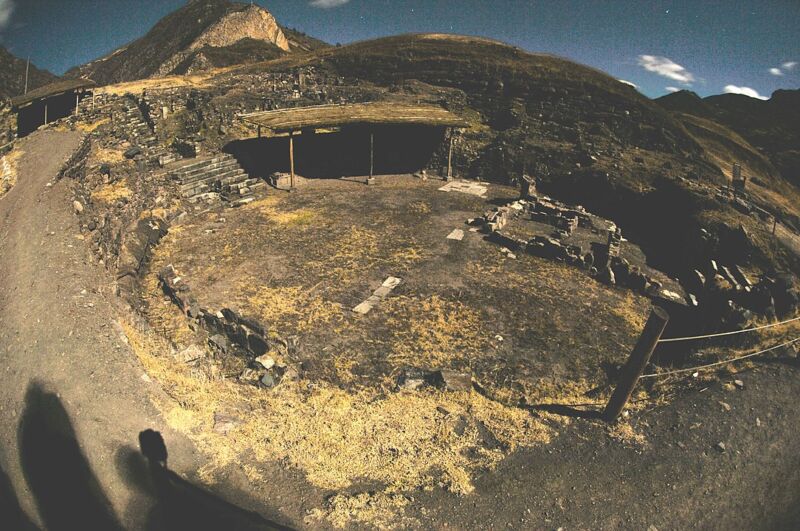
Today, the temples, canals, and plazas of Chavín de Huántar stand mostly in ruins. But the site (about 250 kilometers north of Lima, Peru) was once was the heart of the Chavín culture, a civilization that flourished in the central Andes centuries before the rise of the Inca Empire. Its oldest granite and limestone temples date back to about 1200 BCE, but people have lived at the site for much longer, since at least 3000 BCE.
Even after the Chavín culture’s power faded, members of the Huaraz group used stones from the ancient temples to build a village in an abandoned plaza. People lived at Chavín de Huántar until the 1940s. The place has had a long enough life that, over thousands of years, even the people who lived there lost track of some of its secrets.
Archaeologists rediscovered one of those secrets by accident: a narrow duct leading to a small ritual chamber eight meters deep beneath one of the site’s temple buildings. Based on the style of its architecture, the hidden chamber may be older than any other building or tunnel at the site.
“I put a date of 3,000 years, but I think I’m conservative, and it may be even older,” Stanford University archaeologist John Rick, director of the Chavín de Huántar Archaeological Research and Conservation Program, told Peruvian newspaper El Comercio.
Radiocarbon dating material from the chamber could provide a more definite answer, but that process could take about six months, according to Rick, who plans to do the work himself instead of sending samples to a lab, as is typically done.
A secret chamber “frozen in time”
Rick’s first glimpse of the chamber—now nicknamed the Condor Gallery—came via a robotic camera that he had carefully lowered into the 40-centimeter-wide duct set in a passage between two temples. Archaeologists had been excavating the passage in 2012 when they found the duct, but they didn’t get the chance to investigate with the robotic camera until 2019. In the video, Rick could just make out the dim outlines of a small room with a blurry object sitting in the center of the floor.
The duct probably once provided ventilation for the small chamber, according to Rick. He suggests that the chamber may originally have been a shallow, stone-lined pit where small groups of people could gather for rituals. Later renovations added a roof and walls. But eventually, later construction covered the chamber and its small ventilation shaft completely.
“So the Condor Gallery, as we call it, was frozen in time—no more people entering,” he said.
It took more than a year for the archaeologists to find a way to get inside without damaging the gallery or the temple above it. But earlier this month, Rick squeezed through a narrow opening and found himself standing, hunched over, inside a 1.5-meter-wide, two-meter-long room.
“There is enough space for a very small group to sit on stools, and we will probably also find a hearth because these early temples had a fire cult,” said Rick.

In the center of the chamber sat the object he’d seen through the robotic camera: a heavy stone bowl. Its handles were carved into the shapes of an Andean condor’s head and tail, while the bird’s wings curved along the sides of the bowl. The ornate bowl gave the chamber its name, the Condor Gallery, and it provided another clue about the room’s age.
The carving’s realistic style resembled earlier art from other sites, such as Caral, the 5,000-year-old seat of a city-building culture even older than the Chavín. Later art, including the animals and geometric designs that decorate the walls of Chavín de Huántar’s temples, tended to be more stylized. That, along with the chamber’s architecture—which didn’t look like anything else at Chavín de Huántar—suggested that the room was older than anything else built at the site.
“All of this suggests we’re talking about a connection to the past, with more original sites like Caral,” said Rick.
Subterranean secrets at Chavín de Huántar
The Condor Gallery isn’t the first underground architecture archaeologists unearthed at Chavín de Huántar. The network of subterranean passages under the temples inspired a 1997 hostage rescue operation, Operation Chavín de Huántar. Members of a rebel group called the Túpac Amaru Revolutionary Movement had taken several hundred hostages at the Japanese ambassador’s residence in Lima. Peruvian special forces used tunnels dug from nearby buildings to access the ambassador’s residence.
Two decades later, in 2018, Rick and his colleagues rediscovered 35 more tunnels beneath the site.
The construction project that finally cut the Condor Gallery off from the world probably happened well before 500 BCE. Around that time, the Chavín culture’s political power waned, and the site fell into disuse—at least as a major religious center. Local people built a village in one of the great plazas, borrowing granite and limestone from temple walls to build their homes. They might have known about some of the tunnels and canals beneath their feet, but it’s unlikely that they knew about the Condor Gallery.
reader comments
84